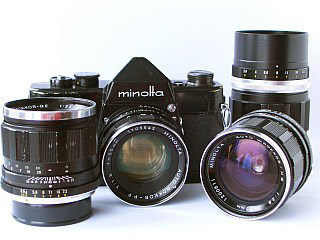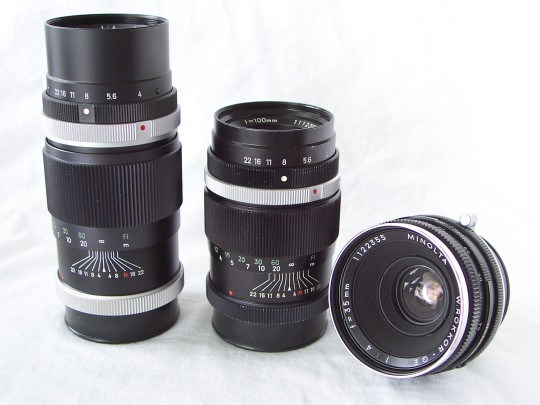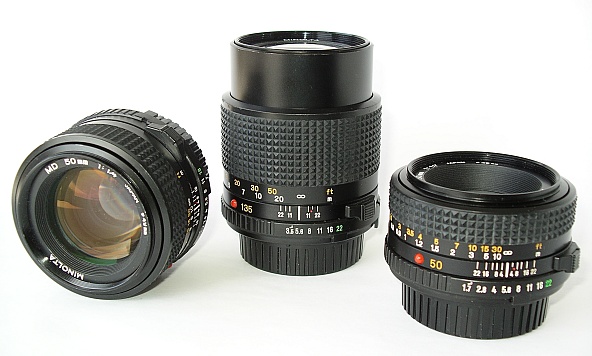Minolta has been making their own optical glass in their Itami works
since 1941, one of the few camera manufacturers with that
capability. Since the start, Minolta has produced excellent lenses for
their SLR cameras. Some of them are outstanding, rivaling the best
ever made. A long standing partner of Minolta has been Leica,
formerly Leitz. Some of the lenses made by Minolta has been
produced and sold under the Leica brand name.
When Minolta introduced their first SLR camera, the SR-2 in 1958,
Minolta started out with four lenses.
These lenses where the 35mm wide angle, a 55mm normal lens, a
100mm short tele lens and a 135mm tele lens.
They where soon followed by a fift, a 200mm tele lens.
 Minolta named their lenses Rokkor, as many other companies
also choose a different name for their lenses. The SR bayonet
mount is unique in being virtually unaltered since introduction. Minolta named their lenses Rokkor, as many other companies
also choose a different name for their lenses. The SR bayonet
mount is unique in being virtually unaltered since introduction.
By adding lugs for aperture information and meter coupling, the
mount has been been able to accommodate all types of automatic
exposure methods. Most other camera makers have been forced to
remake their mount to facilitate more modern features.
From the humble beginning, the Minolta SLR lens line up has grown
to include all kinds of lenses from fisheye to super tele lenses, as
well as some specialized lenses like lenses made for architechural
photography and microscopy.
The first generation of lenses where the Auto Rokkor and Rokkor
lenses. The Auto Rokkors had automatic apertures that returned to
fully open after the exposure had been made. Something very novel
at the time. Rokkor lenses had manually operated diaphragms, but
was priced lower.

From left Rokkor-TC 135mm/4, Rokkor-TC 100mm/4 and Rokkor-QE 35mm/4.
Although cheaper to buy, the workmanship of the Rokkor line was
excellent. The 100mm 1:4 Tele Rokkor has an aperture of no less
than 13 blades and makes almost a perfect circular aperture
opening at all aperture settings.
The Rokkor line was kept as a entry level line after the Auto Rokkor
line was replaced. Offered in 35mm, 100mm, 135mm and 200mm.
Technically all the longer tele lenses belonged to the Rokkor line, as
did the macro lenses, but the price of these specialized lenses was
not economy level. Most specialized lenses from other makers at the
time lacked automatic diaphragms too.
The Auto Rokkor lenses with automatic aperture was first
introduced with the normal lens in Auto Rokkor-PF 55mm 1:1.8,
wide angle Auto Wide Rokkor-HG 35mm 1:2.8 and tele lens Auto
Tele Rokkor-QE 100mm 1:3.5.
The letter codes assigned after the Rokkor name is a code to
display the optical design, how many lenses there are in the lens
and how they are arranged. The first letter tells how many groups
of glass elements there are, the second tells how many lens
elements there are, see more information here.

Auto Rokkor-HG 35mm/2.8, Auto Rokkor-PF 55mm/1.8 and Auto Rokkor-QE 100mm/3.5.
Minoltas success in the SLR market was a combination of
introducing a modern and competent camera paired with good
quality lenses at reasonable prices.
Light metering at this time was done with a separate light meter
and information was transferred to the camera. With the
introduction of the revolutionary Minolta SR-7 in 1962 that had a
built in metering system, Minolta's cameras was preparing for the
next logical step.
In 1966 the Minolta SR-T101 with built in metering system that
measured through the lens at full aperture together with the MC
Rokkor line of lenses marked a huge leap forward in technology.

From left to right; MC W.Rokkor-SG 28mm/3.5, MC Rokkor-55mm/1.7, MC Tele Rokkor-QD
135mm/3.5, MC W.Rokkor-HG 35mm/2.8 and MC Tele Rokkor-QE 100mm/3.5.
The MC Rokkor lenses has an information tab on the aperture ring
which transfers information to the camera which aperture is set,
this enables measuring the correct exposure when the lens remains
at full aperture until the moment of exposure. This is the MC or
Meter Coupled lens tab.
The MC Rokkor line is in appearance quite similar to the previous
Auto Rokkor lenses of later date, but easily identifiable by its
aluminum colored aperture ring.
Todays fully automatic cameras perhaps makes it difficult to
understand something that we take for granted today; the ability to
measure light and still keep the aperture fully open and hence the
view finder bright enough to focus easily. This was revolutionary
when introduced and Minolta was leading the way.
Many other camera manufactorers like Canon and Nikon didn't
reach this level of refinement until years later.
The MC Rokkor lenses was modified during its production run in
cosmetic appearance, but most of their lens designs remained
unchanged except a few of the lenses.
Late in 1972 Minolta presented a new appearance of their lenses
together with the new top of the line camera Minolta XK (XM in
Europe and X-1 in Japan).

From left to right MC W.Rokkor-SG 28mm/3.5, MC Rokkor-PF 50mm/1.7, MC Tele
Rokkor-QD 135mm/3.5, MC W.Rokkor-HG 35mm/2.8 and MC Rokkor-PF 100mm/2.5.
The aluminum aperture ring was painted black and had white
numerals to be more visible in the view finder with cameras that
used periscope to display set aperture.
Most visible was the change from a milled metal focusing ring to a
rubber focusing grip.
In the American continent the new MC Rokkor line was called MC
Rokkor-X, although this was only engraved on the lenses sold in the
American market. The exact same lenses was sold in other markets
but they lacked the -X designation.
In 1975 several of the MC Rokkor lenses was modified and had an
entirely different optical lens design. The easiest way to recognize a
late generation MC Rokkor-X is that they lack the optical design
designation with the two letter codes.
In 1977 it was time for another Minolta first; the advent of multiple
modes of automatic exposure. With the launch of XD-11 (XD-7 in
Europe and XD in Japan) the debate whether shutter prefered or
aperture prefered AE mode was ended by allowing for both AE
methods in the camera.
To be able to use shutter priority Minolta brought out the MD
Rokkor lenses with balanced aperture mechanism and a signaling
tab to inform the camera when minimum aperture was set.

From left MD Tele Rokkor 135mm/3.5, MD Rokkor 35mm/2.8 and XD-11 with MD Rokkor
50mm/1.4 which was one of the redesigned lenses.
Most of the lens designs was carried over from the previous MC
Rokkor lenses, with some new designs.
These lenses are well built optically and mechanically and with this
series Minolta started modernising their design with modern
materials like plastic to save weight and production cost.
The MD Rokkor line, often called MD Rokkor-X for obvious reasons
was also later on modified starting in 1979. This time easily
recognized by their changed cosmetic appearance by having a
tapered look, wider at the lens mount and a switch to ø 49 mm filter
thread.
In 1981 the last major modification of Minolta's manual SLR lenses
was released. The Minolta MD line. Probably in keeping with the
features of the X-700 with programmed AE mode. The new camera
was supposed to be simple to use and to make sure the
photographer always had the lens set at minimum aperture there
was a lock on the lens that you could engage when set at minimum
aperture.

From left Minolta MD 50mm/1.4, Minolta MD 135mm/3.5 and Minolta MD 50mm/1.7.
The MD line was the last of the manual Minolta lenses. In the 1984
brochure of the Minolta lenses I count 53 different lenses from
Fisheye to specialized lenses.
In 1985 Minolta changed the world of photography altogether by
releasing the first auto focus SLR camera, the Maxxum 7000. This
changed the business and all other camera makers chased the
leader Minolta once again. Minolta choose to leave the SR mount for
the auto focus camera to the non compatable AF mount.
Today there are only the used market for those in search for
manual cameras and lenses as new production has ended.
Top
Back
|
 Minolta named their lenses Rokkor, as many other companies
also choose a different name for their lenses. The SR bayonet
mount is unique in being virtually unaltered since introduction.
Minolta named their lenses Rokkor, as many other companies
also choose a different name for their lenses. The SR bayonet
mount is unique in being virtually unaltered since introduction. 




